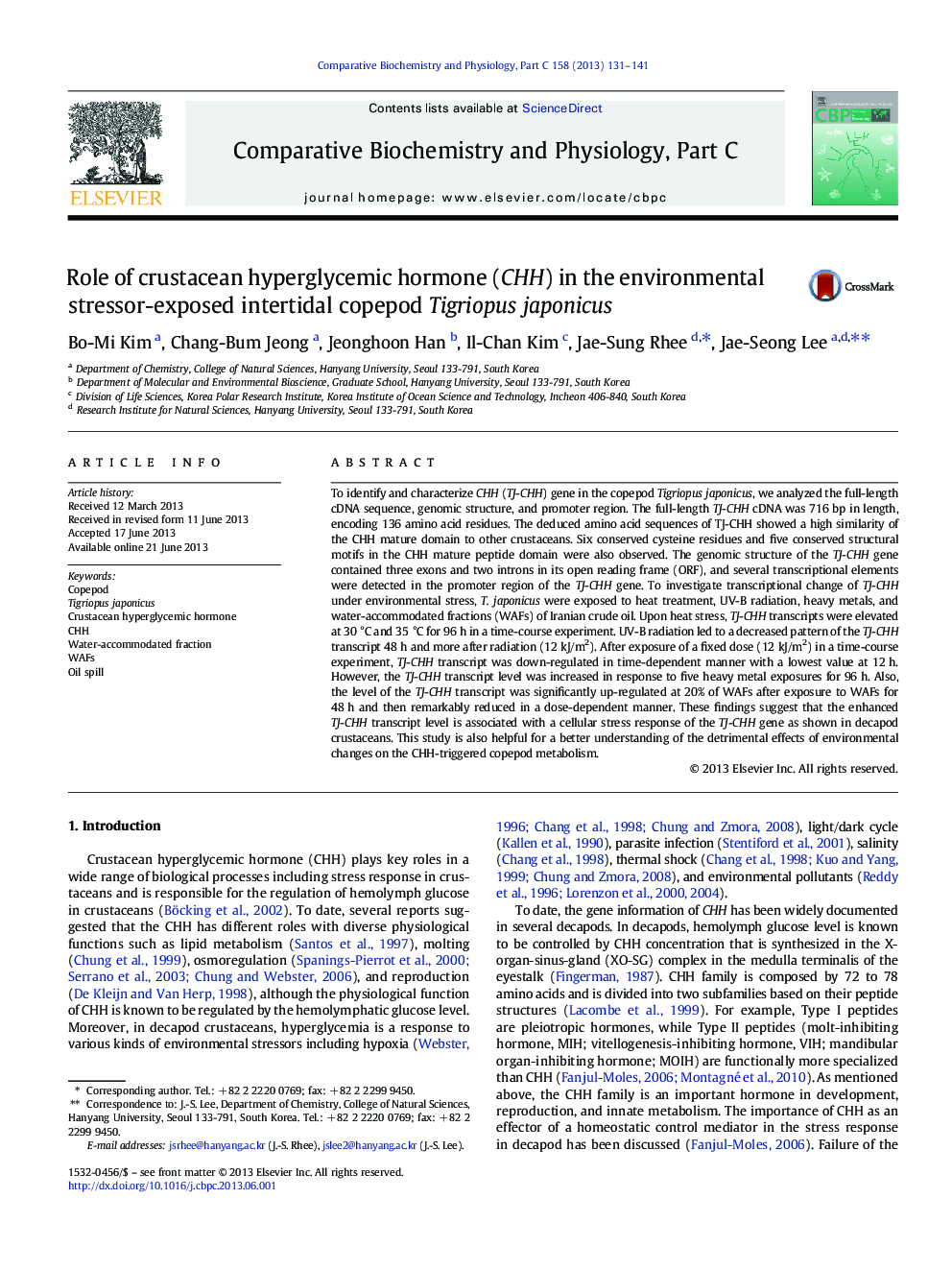| کد مقاله | کد نشریه | سال انتشار | مقاله انگلیسی | نسخه تمام متن |
|---|---|---|---|---|
| 10821631 | 1061482 | 2013 | 11 صفحه PDF | دانلود رایگان |
عنوان انگلیسی مقاله ISI
Role of crustacean hyperglycemic hormone (CHH) in the environmental stressor-exposed intertidal copepod Tigriopus japonicus
دانلود مقاله + سفارش ترجمه
دانلود مقاله ISI انگلیسی
رایگان برای ایرانیان
کلمات کلیدی
موضوعات مرتبط
علوم زیستی و بیوفناوری
بیوشیمی، ژنتیک و زیست شناسی مولکولی
زیست شیمی
پیش نمایش صفحه اول مقاله

چکیده انگلیسی
To identify and characterize CHH (TJ-CHH) gene in the copepod Tigriopus japonicus, we analyzed the full-length cDNA sequence, genomic structure, and promoter region. The full-length TJ-CHH cDNA was 716 bp in length, encoding 136 amino acid residues. The deduced amino acid sequences of TJ-CHH showed a high similarity of the CHH mature domain to other crustaceans. Six conserved cysteine residues and five conserved structural motifs in the CHH mature peptide domain were also observed. The genomic structure of the TJ-CHH gene contained three exons and two introns in its open reading frame (ORF), and several transcriptional elements were detected in the promoter region of the TJ-CHH gene. To investigate transcriptional change of TJ-CHH under environmental stress, T. japonicus were exposed to heat treatment, UV-B radiation, heavy metals, and water-accommodated fractions (WAFs) of Iranian crude oil. Upon heat stress, TJ-CHH transcripts were elevated at 30 °C and 35 °C for 96 h in a time-course experiment. UV-B radiation led to a decreased pattern of the TJ-CHH transcript 48 h and more after radiation (12 kJ/m2). After exposure of a fixed dose (12 kJ/m2) in a time-course experiment, TJ-CHH transcript was down-regulated in time-dependent manner with a lowest value at 12 h. However, the TJ-CHH transcript level was increased in response to five heavy metal exposures for 96 h. Also, the level of the TJ-CHH transcript was significantly up-regulated at 20% of WAFs after exposure to WAFs for 48 h and then remarkably reduced in a dose-dependent manner. These findings suggest that the enhanced TJ-CHH transcript level is associated with a cellular stress response of the TJ-CHH gene as shown in decapod crustaceans. This study is also helpful for a better understanding of the detrimental effects of environmental changes on the CHH-triggered copepod metabolism.
ناشر
Database: Elsevier - ScienceDirect (ساینس دایرکت)
Journal: Comparative Biochemistry and Physiology Part C: Toxicology & Pharmacology - Volume 158, Issue 3, September 2013, Pages 131-141
Journal: Comparative Biochemistry and Physiology Part C: Toxicology & Pharmacology - Volume 158, Issue 3, September 2013, Pages 131-141
نویسندگان
Bo-Mi Kim, Chang-Bum Jeong, Jeonghoon Han, Il-Chan Kim, Jae-Sung Rhee, Jae-Seong Lee,